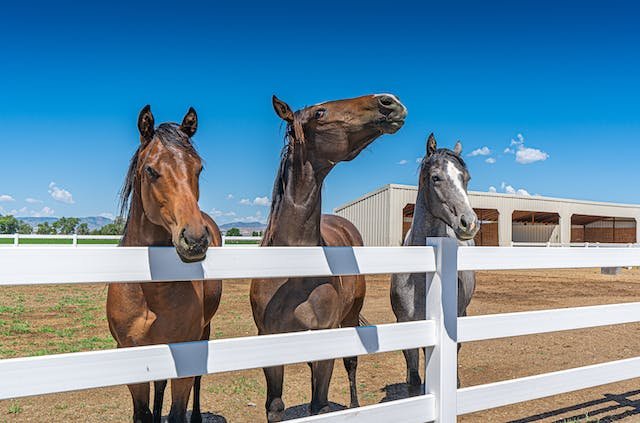Do you know What Is The 10 Common Signs Of Aggression In Horses? Any behavior, including verbal events, which involves attacking another person, animal, or object with the intent of harming the target. Similarly, violence is intentionally using physical force to hurt, damage, or kill someone or something.
Table of Contents
Aggression in horses is a serious behavior issue that can pose a danger to both the horse and those around it. It’s important for horse owners and handlers to be able to recognize signs of aggression in order to prevent accidents and injuries. Here are 10 common signs of aggression in horses:
- Ears pinned back: This is one of the most obvious signs of aggression in horses. When a horse’s ears are flattened against their head, it typically means they are feeling angry or defensive.
- Tail swishing: Similar to pinned back ears, a horse may swish its tail as a warning sign of aggression. This movement can also indicate annoyance or impatience.
- Bared teeth: A horse baring its teeth is a clear sign of aggression. This is often accompanied by snarling or snapping noises.
- Striking: When a horse raises one or both front legs and kicks out, it’s a sign of aggression. This behavior can be dangerous and should not be taken lightly.
- Lunging: If a horse suddenly charges forward with its head lowered, this is known as lunging and is a sign of aggression.
- Charging: Similar to lunging, charging involves the horse running towards someone or something aggressively. This can be very dangerous and should be addressed immediately.
- Biting: Horses may bite as a form of aggression, especially if they are feeling threatened or territorial.
- Flared nostrils: When a horse flares its nostrils, it’s often a sign of tension and can precede aggressive behavior.
- Body language: Horses may also display aggression through their body language, such as standing stiffly or arching their neck. It’s important to pay attention to these signs and address them before they escalate.
- Vocalizations: Horses may make certain sounds when feeling aggressive, such as snorting or neighing loudly. These vocalizations can be a warning sign of potential aggression.
What Are The Types Of Aggression:
There are several types of aggression that can be displayed by horses. These include:
- Dominance Aggression: This type of aggression is seen in cases where a horse is trying to establish itself as the leader within a herd or group.
- Territorial Aggression: Horses may become aggressive when they feel their territory is being invaded by other animals or people.
- Maternal Aggression: Mares may display aggression when protecting their offspring, especially if they feel threatened.
- Fear Aggression: Horses can also exhibit aggressive behavior when they are afraid or feel threatened. This is often seen in situations where the horse feels trapped or unable to escape.
- Pain-Related Aggression: If a horse is experiencing pain or discomfort, it may act out aggressively in response.
- Learned Aggression: In some cases, horses may learn aggressive behaviors from previous experiences or from other horses.
What Causes Aggression In Horses?

There are various factors that can contribute to aggression in horses, including:
- Genetics: Some horse breeds may be predisposed to certain behavioral traits, including aggression.
- Lack of socialization: Horses that have not been properly socialized as foals may struggle with understanding appropriate behavior towards humans and other animals.
- Training methods: Harsh or inconsistent training methods can lead to fear and aggression in horses.
- Fear or insecurity: Horses that have had negative experiences, such as abuse or neglect, may exhibit aggression as a defense mechanism.
- Hormonal imbalances: Certain hormonal imbalances, such as high levels of testosterone in stallions, can contribute to aggressive behavior.
Why Do Horses Become Aggressive?
In many cases, aggression in horses is a response to a perceived threat or challenge. Horses are prey animals and may react aggressively when they feel their safety is at risk. Additionally, some horses may become aggressive due to past experiences or learned behaviors. It’s important for horse owners and handlers to be aware of potential triggers for their horse’s aggression and work to address them in a safe and effective manner.
Seeking professional help, such as hiring a trainer or behavior specialist, can also be beneficial in addressing the root causes of aggression and helping to modify the horse’s behavior. With proper care and management, many cases of aggression in horses can be resolved or managed effectively.
Body Language Signs Of Aggressive Horse
Understanding a horse’s body language can help in recognizing signs of potential aggression. Some common body language signs of an aggressive horse include:
- Stiffening or tensing of the muscles
- Pinned back ears
- Snarling, snapping or baring teeth
- Tail swishing and flicking
- Raised head and neck
- Rearing or kicking out
- Charging forward with lowered head and ears flat against the neck
It’s always advisable to approach any horse with caution and respect, as even well-trained horses can exhibit aggressive behavior.
What Are The Facial Expression Of Aggressive Horse?

As mentioned earlier, horses can display aggression through their facial expressions as well. Some common facial expressions of an aggressive horse include:
- Flared nostrils
- Wide eyes with a tense or angry expression
- Wrinkled muzzle with bared teeth
- Raised upper lip (known as the “flehmen” response)
What Are The Vocalizations Of Aggressive Horse?
Horses may also make certain sounds when feeling aggressive. These vocalizations can vary depending on the type and intensity of aggression, but some common ones include:
- Snorting or blowing air through the nostrils
- Loud neighing or whinnying
- Growling or snarling
- Grunting or squealing
Environmental Triggers For Aggression In Horses
Apart from internal factors, there are certain environmental triggers that can also contribute to aggression in horses. These include:
- Overcrowding: When horses are kept in close proximity with limited space, they may become frustrated and exhibit aggressive behavior towards one another.
- Lack of resources: Horses may become aggressive when food, water, or other resources are limited and they feel the need to compete for them.
- Changes in routine or environment: Horses can become stressed and exhibit aggressive behavior when there are sudden changes in their routine or living environment.
Understanding these triggers and minimizing their impact on a horse’s daily life can help prevent potential incidents of aggression.
Horses Aggression’s Towards Other Horses And Humans

Horses can display aggression towards other horses and humans for various reasons. Some common causes of aggression towards other horses include competition over resources, establishing dominance in a herd, or feeling threatened by another horse’s behavior. Aggression towards humans is often seen as a response to fear or frustration, but it can also be learned through negative experiences or poor handling.
Health And Pain-Related Aggression Of Horses
As mentioned earlier, pain or discomfort can be a significant factor in a horse’s aggressive behavior. If a horse is experiencing pain due to an injury, illness, or improper tack and equipment, it may act out aggressively as a means of communication.
Preventing And Managing Aggressive Behavior In Horses
Preventing and managing aggression in horses requires thorough understanding of the underlying causes and appropriate training and handling techniques. Some tips for preventing and managing aggression in horses include:
- Proper socialization and desensitization from a young age
- Consistent, positive reinforcement-based training methods
- Addressing any potential triggers or sources of fear or discomfort for the horse
- Seeking professional help when needed
- Maintaining a safe and respectful relationship with the horse at all times.
Final Thoughts
It’s essential to understand and address aggression in horses to ensure the safety of both the horse and those around them. By being aware of the types, causes, and signs of aggression, as well as seeking professional help when needed, owners and handlers can work towards creating a safe and harmonious relationship with their equine companions. Remember to always approach horses with respect and caution, be mindful of their body language, and address any potential triggers for aggression in a calm and patient manner.
Read Also: Are Bowhead Whales Dangerous?





